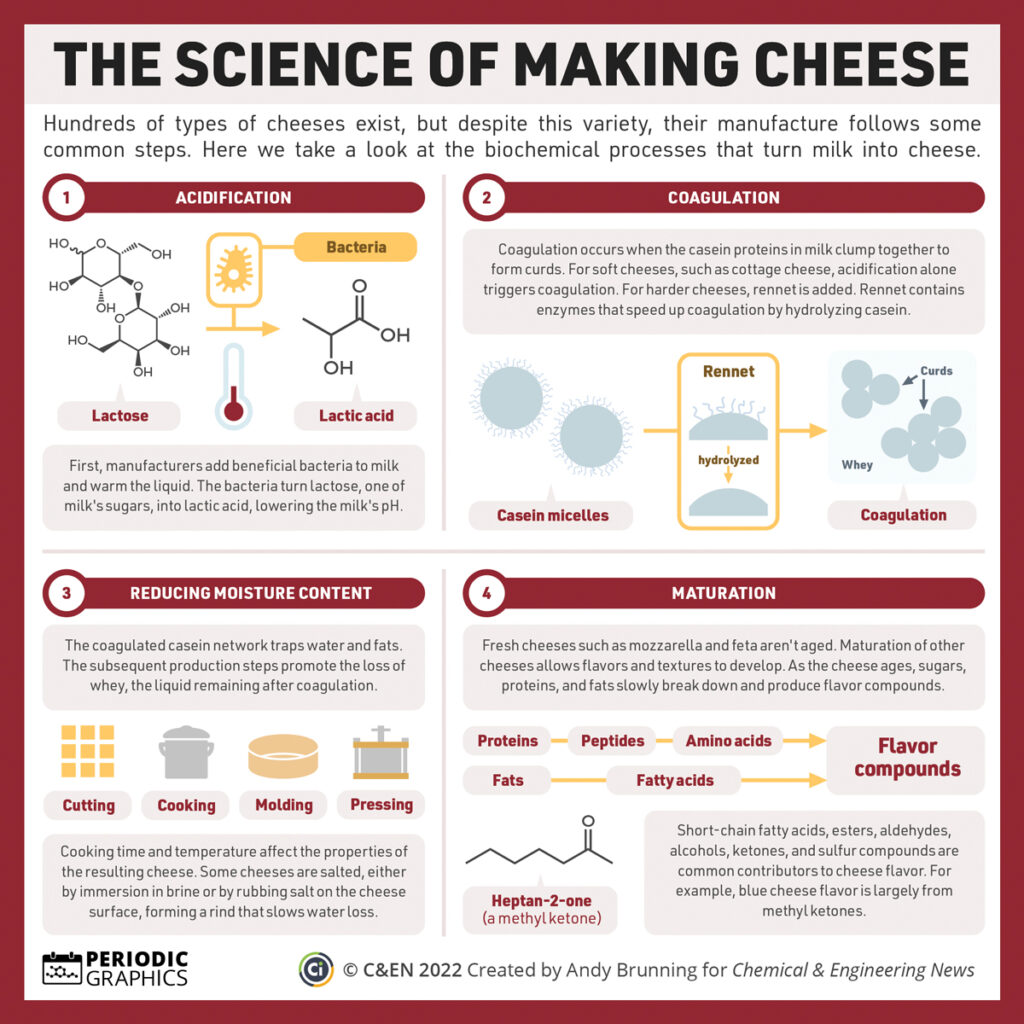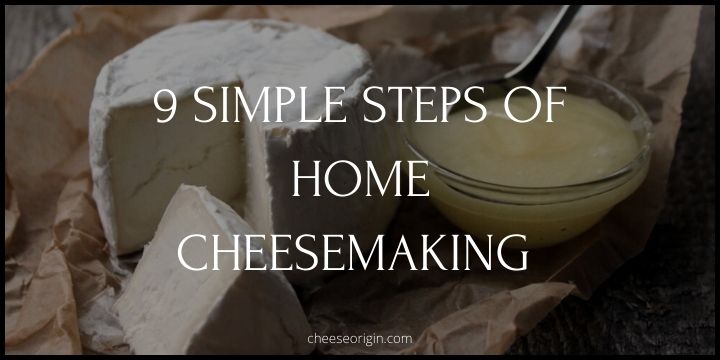The Science of Cheesemaking: A Journey from Milk to Artisanal Delight

Have you ever wondered how a simple liquid like milk transforms into the rich, creamy, and diverse range of cheeses that we all love and enjoy?
The process is not just an art, but also an intricate dance of science. Welcome to the fascinating world of cheesemaking, where biology and chemistry play as important a role as traditional techniques and craftsmanship.
In this post, we will embark on a journey that begins in the dairy farm and ends at your cheeseboard.
We’ll delve into the scientific details that underpin each step of the cheesemaking process, from the initial acidification of milk and the formation of curds and whey, to the role of bacteria and molds in aging the cheese to perfection.
What is the Science Behind Making Cheese?
1. The Building Blocks: Components of Milk:
The journey begins with milk, a nutrient-rich liquid that serves as the raw material for cheese.
Milk is largely composed of water, but it’s the other components – proteins (casein and whey proteins), fats, lactose (milk sugar), minerals, vitamins, and enzymes – that play critical roles in cheesemaking.
2. The Role of Bacteria and Mold:
During the initial stages of cheesemaking, specific strains of bacteria are added to the milk. These bacteria consume lactose and produce lactic acid, a process known as fermentation. This acidification process lowers the pH of the milk, causing the casein proteins to denature and form a curd.
Certain types of cheese (like blue cheese or camembert) also incorporate mold spores, which contribute to their unique flavor profiles and textures. These molds grow during the aging process, breaking down proteins and fats into flavor compounds that give each type of cheese its distinctive taste.
Also read: The role of Bacteria, Mold & Yeast in Cheesemaking
3. The Curdling Process: Enzymes at Work:
Enzymes, particularly rennet, play a crucial role in curdling. Rennet contains the enzyme chymosin, which cleaves a specific peptide bond in kappa-casein, the protein that keeps milk in its liquid form.
This enzymatic action causes the milk proteins to aggregate, forming a network that traps fat and water molecules, creating the solid curds.
4. Whey Separation and the Role of Temperature:
Once the curd has formed, it’s cut into pieces, which allows whey (the watery part of milk) to separate. The size of the curd pieces can affect the texture of the final cheese – smaller pieces yield harder cheese as more whey is released.
Temperature is another key factor in this stage. Heating the curds expels more whey and leads to a firmer cheese. Additionally, temperature controls the activity of the bacteria, influencing the rate of acid production and, consequently, the flavor and texture of the cheese.
5. The Intricate Dance of pH and Other Factors:
Throughout cheesemaking, the pH level continues to drop due to ongoing fermentation, which further affects the curd’s texture. Lower pH levels result in a firmer, more crumbly cheese. Other factors like salting, pressing, and aging also contribute to the final product’s characteristics.
In short, the process of making cheese is a delicate balance of science and art, a testament to our ability to harness biological and chemical processes to create something remarkable.
>> Also read: What is Affinage in Cheesemaking? (RIPENING)
What are the 4 Processes that Occur During Cheesemaking?
| Step | Description |
|---|---|
| 1. Acidification | Specific bacteria are added to milk to ferment lactose into lactic acid, lowering the milk’s pH. |
| 2. Coagulation | Rennet, containing the enzyme chymosin, is added to cleave casein proteins, leading to curd formation. |
| 3. Curd Cutting and Cooking | The curd is cut into pieces and heated, expelling more whey and denaturing proteins for texture. |
| 4. Pressing and Aging | Curds are pressed for shape and aged, during which enzymes and microbes break down proteins and fats for flavor. |

How is Making Cheese a Chemical Reaction?
Making cheese is a complex process that involves several chemical reactions, mainly involving the proteins and fats in milk.
Here’s a simplified breakdown of the chemistry involved:
- Acidification: The first step in cheesemaking is acidification, where specific bacteria are added to the milk. These bacteria ferment lactose (milk sugar) into lactic acid. This is a fermentation reaction, a type of anaerobic respiration, which lowers the pH of the milk.
- Coagulation: The next step is coagulation, where an enzyme called rennet is added. Rennet contains the enzyme chymosin, which cleaves kappa-casein, one of the milk proteins. This enzymatic action destabilizes the micellar structure of the casein, causing it to aggregate and form a gel-like network, trapping fat and water molecules. This is the curd.
- Curd Cutting and Cooking: The curd is then cut into smaller pieces and heated, resulting in further expulsion of whey (the liquid part of milk). The heat also denatures the proteins further, helping them link together more tightly and expel more whey. The size of the curd pieces and the cooking temperature can affect the final texture of the cheese.
- Pressing and Aging: The curds are often pressed to remove more whey and compact them into a specific shape. During aging, the cheese undergoes further biochemical changes driven by enzymes and microbes. Proteins and fats are broken down into a variety of compounds that give each type of cheese its unique flavor and texture.So, overall, cheesemaking is a series of chemical reactions involving enzymatic processes, protein denaturation and reformation, and microbial fermentation. Each step is carefully controlled to produce the desired characteristics of the final cheese product.
Why is Milk Heated Before Making Cheese?
Heating milk is an essential step in the cheese-making process for several reasons:
- Safety: Heating milk helps to kill harmful bacteria that could potentially lead to foodborne illness. This process, known as pasteurization, involves heating milk to a specific temperature for a certain amount of time.
- Improved Coagulation: Warm milk is more receptive to the starter cultures and rennet (an enzyme) added during cheese making. These ingredients help the milk coagulate, or form curds, which are the basis of cheese. Heating the milk aids in this process by helping the proteins in the milk to bond together more easily, creating a better structure for the cheese.
- Flavor Development: The heat also helps activate the lactic acid bacteria added as starter cultures. These bacteria play a crucial role in flavor development, as they ferment the lactose in the milk into lactic acid, which gives cheese its characteristic tanginess.
- Consistency: Heating ensures a consistent product by ensuring that all the proteins and fats are evenly distributed throughout the milk.
So, heating milk is not just about safety—it’s also about improving the texture, flavor, and consistency of the final cheese product.
What is the Science Behind Rennet?
Rennet is a complex of enzymes, primarily including chymosin (also known as rennin), that plays a crucial role in cheesemaking.
The science behind rennet involves biochemistry and enzymology.
- Enzyme Action: Rennet contains chymosin, an enzyme that specifically acts on kappa-casein, a milk protein. Chymosin cleaves kappa-casein at a specific point, converting it from a soluble form to a form that aggregates together. This action destabilizes the micellar structure of the casein proteins in milk.
- Coagulation: As a result of the enzymatic action, the casein proteins aggregate and form a gel-like network, or curd, that traps fat and water molecules. This process is known as coagulation and is a critical step in cheese production.
- Curd Formation: The formation of the curd is due to the change in the proteins’ structure and the interactions between the proteins. The curd can then be cut and processed further to produce cheese.
The effectiveness of rennet in promoting coagulation is influenced by several factors, such as the pH of the milk, its temperature, and the concentration of calcium ions.
Cheesemakers control these parameters carefully to achieve the desired texture and flavor in their cheeses.
What are the 3 Main Components of Cheese?
- Casein Proteins: These are the main proteins in milk and form the structure of cheese. During cheesemaking, casein proteins coagulate (clump together) to form curds. The specific type and arrangement of casein proteins influence the texture and flavor of the cheese.
- Fat: The fat in cheese comes from the milk it’s made from. Fat contributes to the creamy texture and rich flavor of cheese. The amount of fat can vary greatly between different types of cheese, affecting their calorie content and taste.
- Water: The water content in cheese affects its hardness or softness. Cheeses with a high water content (like mozzarella or ricotta) are softer, while those with low water content (like Parmesan or Romano) are harder.
What is the Most Important Ingredient in Cheese?
The most important ingredient in cheese is milk. The quality, type, and treatment of the milk used directly determine the texture, flavor, and overall quality of the cheese produced.
Milk from different types of animals (like cows, goats, or sheep) can significantly influence the taste and characteristics of the cheese. For instance, goat’s milk gives a tangy flavor, while cow’s milk is often more mild and creamy.
Factors such as the diet of the animals, the time of year the milk is collected, and the specific breed of the animal can all contribute to variations in the flavor profile of the milk, and therefore, the resulting cheese.
In essence, without milk, there would be no cheese.
Also read: The Amount of Milk Required to Make Cheese
What Makes Cheese Taste Stronger?
- Type of Milk: The type of milk used (cow, goat, sheep, etc.) can alter the taste of the cheese. Each type of animal’s milk has a unique composition of fats, proteins, and other compounds that contribute to flavor.
- Bacteria and Cultures: Specific bacteria cultures are added to the milk during cheesemaking. These bacteria ferment lactose (milk sugar) into lactic acid, which gives cheese its characteristic tangy flavor. Different bacteria strains produce different flavor profiles, contributing to the diversity of cheese flavors.
- Age: As cheese ages, its flavors intensify. The aging process allows for the development of more complex flavors through the breakdown of proteins and fats by enzymes and bacteria. This produces a range of flavorful compounds, including fatty acids and volatile sulfur compounds (VSCs), which are associated with stronger, more pungent flavors.
- Process: The specific processes used in cheesemaking, such as the addition of molds, washing the rind, or smoking the cheese, can also influence flavor.
- Umami: Some aged cheeses, like Parmesan and Gouda, have high levels of glutamates, which contribute to the savory, umami taste.
- Temperature: Cheese often tastes better when it’s melted because heat releases aroma compounds and makes the texture smoother, both of which enhance our perception of flavor.
Conclusion
The next time you savor a piece of cheese, remember the science behind its creation.
From the simple starting point of milk, through the careful application of heat and bacteria, to the patient waiting game of aging – each step in the cheesemaking process is a testament to the power of science to transform basic ingredients into culinary delights.
Truly, cheesemaking is a remarkable blend of art, craft, and science.
Also read:





